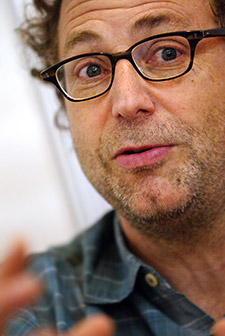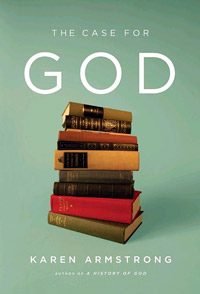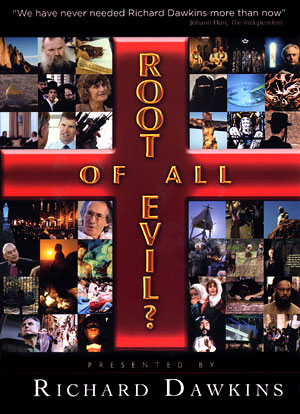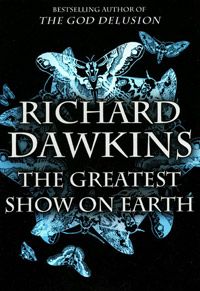up next: physicist Dr. Leonard Mlodinow
The Drunkard’s Walk:
How Randomness
Rules Our Lives
SUNDAY, March 21, 2010 at 2 pm
A DRUNKARD’S WALK is a type of random statistical distribution with important applications in scientific studies ranging from biology to astronomy. Mlodinow, a visiting lecturer at Caltech and coauthor with Stephen Hawking of A Briefer History of Time, takes us on a walk through the hills and valleys of randomness and how it directs our lives more than we realize. MORE…
Books by Leonard Mlodinow
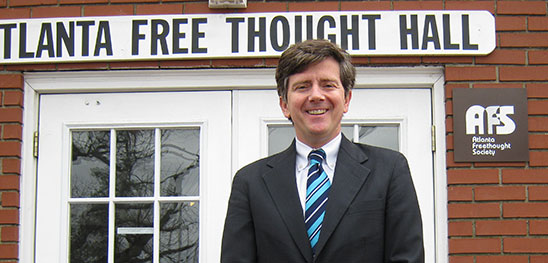
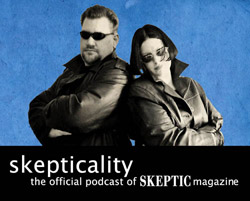
Church State Update
This past week has been particularly troubling for secular humanists and freethinkers, as the Ninth Circuit Court of Appeals ruled that the words “In God We Trust” on American currency and “Under God” as part of the Pledge of Allegiance are not in violation of the First Amendment rights of nontheists.
Meanwhile, the conservative majority of the Texas State Board of Education (whose sheer size and buying power influence textbook content nationwide) revised its curricula to reflect a less secular version of history, economics and sociology. Among other revisionist changes, this reduces the role of President Thomas Jefferson as a revolutionary author.
This week on Skepticality, Swoopy talks with Sean Faircloth (the new Executive Director of the Secular Coalition for America) about these troubling current events. Sean also talks about the Coalition’s recent historic meeting with White House officials to open a policy dialog with the Obama Administration — the first of its kind for American nontheists.
In this week’s eSkeptic, Kenneth Grubbs reviews The Greatest Show on Earth: The Evidence for Evolution by Richard Dawkins as well as and The Case for God by Karen Armstrong. Kenneth Grubbs is a freelance writer living in Michigan.
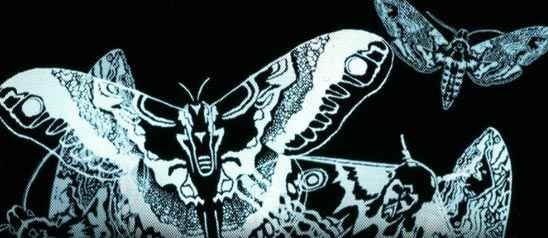
The Greatest Show on Earth (detail of cover)
Is There Not Grandeur in this View?
book reviews by Kenneth Grubbs
“ONE OF THE CONDITIONS OF ENLIGHTENMENT has always been a willingness to let go of what we thought we knew in order to appreciate truths we had never dreamed of.” Does this compelling passage originate from Karen Armstrong’s newest release, The Case for God, or did Richards Dawkins pen these words in his most recent achievement, The Greatest Show on Earth? Read on to find out.
Karen Armstrong once steeped herself for seven isolating years in the confines of a strict Catholic Order in England. She resigned the Order in 1969 shortly before suffering a collapse and the eventual diagnosis of epilepsy. But in spite of being soured to the rigors of modern Christian doctrine, Armstrong’s spirituality has nevertheless grown, both in scope and diversity. This latest offering, The Case for God, is an epic historical journey interpreting the rise and fall of humanity’s perceptions of God. The author’s personal perspective lends weight and insight to her words. She begins by asking the reader to understand that pre-modern religion originated as an action, not as a belief. She writes, “Religion, therefore was not primarily something that people thought but something they did. Its truth was acquired by practical action.”
Armstrong goes on to explain that most pre-modern cultures came to recognize two distinct ways of thinking — the Greeks called them mythos and logos. “Logos (reason), was the pragmatic mode of thought,” but for understanding human suffering or the ultimate meaning of life, “people turned to mythos (myth, meaningful stories).” Spiritual transcendence was a process wherein one arrives at a place beyond words or thought, a state of “unknowing,” or ekstasis.
Armstrong tells us that even early Christianity was to be, “imparted in a ritualized setting to people who were properly prepared and were eager to be transformed by it.” It wasn’t until the 4th century that, “Christianity had begun to move in a slightly different direction and developed a preoccupation with doctrinal correctness that would become its Achilles’ heel.”
During the 7th century many Greek philosophers began to consider a more materialistic view of the world. They grew interested in sailing, astronomy, mathematics, and geography. “They wanted to show that thunderbolts and lightning were not arbitrary whims of Zeus, but expressions of fundamental physical laws,” Armstrong explains. Philosophers and theologians began to apply reason to the truths of faith; a methodology that Armstrong suggests would eventually lead to their undoing.
Centuries later, discoveries in mathematics, astronomy, and physics — by Copernicus, Kepler, and Brahe — were still being viewed through the lens of God. Kepler believed that “Geometry was God’s language.” Other great minds of the 17th and 18th centuries — the likes of Galileo and Newton — continued to mold scientific discoveries from the clay of divinity. Philosopher and theologian alike were determined to embody the new sciences as the work of God.
Armstrong walks the reader through the influences of Descartes, Pascal, and Locke; men who also found that “the natural world gave ample evidence for God.” She quotes Pascal stating, “Christianity was about to make a serious mistake.” Many theologians wanted to bring the clarity of the sciences into the Christian discourse, but as Pascal pointed out, “A God who was merely the ‘author of mathematical truths and of the order of the elements’ could bring no light to the darkness and pain of human existence.”
The Church would find itself in the unenviable position of defending the literal inerrancy of its texts and doctrines. The sacred mythos and ekstasi of antiquity were fading. By the late 18th century, “Reason was the only path to truth.” Armstrong tells us that for the first time there arose a divisive “polarity of natural versus supernatural.” With such tumult came vulnerability. The stage was now set. In November, 1859, Charles Darwin published The Origin of Species by Means of Natural Selection.
Enter Richard Dawkins, the well-known evolutionary biologist and author of many ground-breaking works of science. His latest offering, The Greatest Show on Earth, is for Dawkins a well-deserved return to his roots. Far from the full-frontal assault on religion and belief in God found in The God Delusion, this new work is instead an updated exploration of the evidence confirming evolution by natural selection. Dawkins begins profoundly confident, “We don’t need fossils, the case for evolution is watertight without them.” Which is why, he continues, “it is paradoxical to use gaps in the fossil record as though they were evidence against evolution.”
item of interest…
A beautiful new digital transfer from the master, with new artwork and special features. In this two-part documentary, Oxford Professor Richard Dawkins examines how religious faith is gaining ground in the face of rational, scientific truth. The program takes you to some of the world’s religious hot-spots. Dawkins meets with religious leaders and their followers, as well as scientists and skeptics to examine the power of religion. More…
ORDER the DVD
The Greatest Show on Earth is a delicious buffet of evolutionary facts. Among them is the remarkable tale of whales and dolphins. As fascinating as it is that evolution began selecting for adaptations that would bring the ancestors of these creatures ashore during the Ordovician Period, (510–439 mya), it is even more fascinating that some of these land mammals evolved back to the sea! Before molecular genetics, the whale and dolphin family tree remained enigmatic. The nature of these peaceful sea dwellers likened them to mammals, with live births, air breathing, and vestiges of terrestrial limbs. However, as Dawkins explains, “molecular genetic evidence shows that the closest living cousins of the whales are hippos,” which evolved from sea, to land, to sea again.
In another remarkable story, Dawkins untangles the recurrent laryngeal nerves. Two of the many cranial nerves begin at the cranial stem and head toward their final destination in the larynx. One of them, as we would expect, takes the short direct route. The other takes a seemingly ludicrous excursion south, through the chest cavity, below the heart, makes a u-turn, and comes right back up to terminate at the larynx. Dawkins can’t help but remark, “If you think of it as the product of design, the recurrent laryngeal nerve is a disgrace.”
If however one examines this phenomenon with evolutionary eyes, we learn that our aquatic ancestor’s embryonic brachial arches formed gills as well as the ventral aorta. As these features evolved, the connections were maneuvered to facilitate new features. Instead of altering the laryngeal nerve path to a more direct route (thereby avoiding disgrace), it was pushed aside during the transition and there it remained. What we’re left with today is our own comically circuitous laryngeal nerve route. The laryngeal nerve is an example of history, not design.
Dawkins’ excitement for these evolutionary narratives is at its peak with his impassioned explanation of the crucial Lenski experiments. Bacteriologist Richard Lenski and his colleagues at Michigan State University have been conducting experiments that are a “beautiful demonstration of evolution in action.” Beginning in 1988, the Lenski team has followed the evolutionary lineages of 12 separate populations of the bacterium Escherichia coli. For bacteria, generations are measured in hours or even minutes, making them the perfect organism for evolutionary studies. These generational flasks of E coli also contain a carefully controlled brew of nutrients, primarily glucose, providing researchers the ability to tinker with the population’s capacity to process its food. Right around 33,000 generations, one of the 12 lineages suddenly exploded in population density by more than six fold over the other 11 lineages. To use Dawkins’ own vernacular, this one lineage “suddenly went berserk.”
This sudden dramatic growth was astonishing, and the explanation for it is breathtaking. Although the “broth” in each flask was primarily glucose, it contained other nutrients as well, one of which was citrate. But E. coli cannot process citrate as food, unless it mutates, which is exactly what it did. It changed the rules. It developed the ability to eat citrate. It evolved. This lineage, from so simple a beginning, had had enough of the restricted glucose diet, and figured out how to eat citrate!
Dawkins continues with more ineffable examples of evolution in action. Trees grow constantly taller at enormous evolutionary cost in their competitive fight for sunlight. Ichneumon wasps lay their eggs in the paralyzed yet still living bodies of caterpillars so that the new larvae have instant access to a sustainable food supply. (An inconceivably torturous methodology no compassionate designer would employ).
The Greatest Show on Earth is a straightforward and inspiring exegesis of evolution by means of natural selection. It is by no means overtly anti-creation. Dawkins does not rail against the book of Genesis. He doesn’t need to. He need only explain Darwin’s theory of incremental steps trudging mindlessly through time.
Yet the theory of evolution is more than that. Darwin’s revelation imparted something well beyond common ancestry and natural selection. He wrenched darkness from our eyes to illuminate a process of thought, an entirely new way of thinking about the world around us. There is a greater truth in the knowledge and understanding of evolutionary theory than there is in evolution alone.
Karen Armstrong writes with subtle sorrow for the lost mythos of antiquity, for the Ancient Mysteries, for the Pythagorean initiations, and for the Greek ekstasis. She shuns the modern anthropomorphic God of Creation and rejects the notion of inerrant religious texts. She writes, “The result is that many of us have been left stranded with an incoherent concept of God.”
The reader senses her longing for a deeper more transcendent truth, for mankind’s earliest experience with the divine before the spiritually narrowing notion of a supernatural Creator. She admires the ancient philosophies and the concept of connectedness. Of Aristotle she writes, “His biological research was a spiritual exercise.” Although Armstrong still clings to the occasional supernatural supposition, she passionately embraces a rich and fulfilling idea of oneness with nature and the universe.
At the same time, Richard Dawkins teaches us that all life evolved from the simplest forms and shares genetic ancestry with every other living thing from apes and birds to insects and oak trees, an ancestry shared with life forms extinct for a billion years. There is most assuredly a deep sense of the unmistakable connectedness through all of life in his narrative. Is there any room then to consider that these two authors are perhaps speaking of something far more similar than we may have first thought? Do the simple and graceful facts of The Greatest Show on Earth in any subtle way connect the dots to a more transcendent truth, to a kind of ekstasis from pre-modern philosophies that Armstrong yearns for in The Case for God? “One of the conditions of enlightenment has always been a willingness to let go of what we thought we knew in order to appreciate truths we had never dreamed of.” Yes, those words come from Armstrong, not Dawkins.
If we pause for only a moment to consider, among other things, the sprinkling of heavy dust from long forgotten supernova resting gently within us; if we consider quantum entanglement, singularities and super strings; and if we consider the quiet genetic code of ancestors extinct for a billion years still written in our hundred trillion cells; does it not seem, as Socrates might have phrased it, that no matter how much we think we know, there actually is a more transcendent truth? Is there not grandeur in this view?

NEW ON SKEPTICBLOG.ORG
Faces of Skepticism
In this week’s Skepticblog post, Daniel Loxton honors Robynn “Swoopy” McCarthy as one of the definitive faces of skepticism. Swoopy appears in the new “I’M A SKEPTIC” series of graphic banners on skeptic.com promoting skeptical activists who are making a difference in the world of skepticism and critical thinking.


